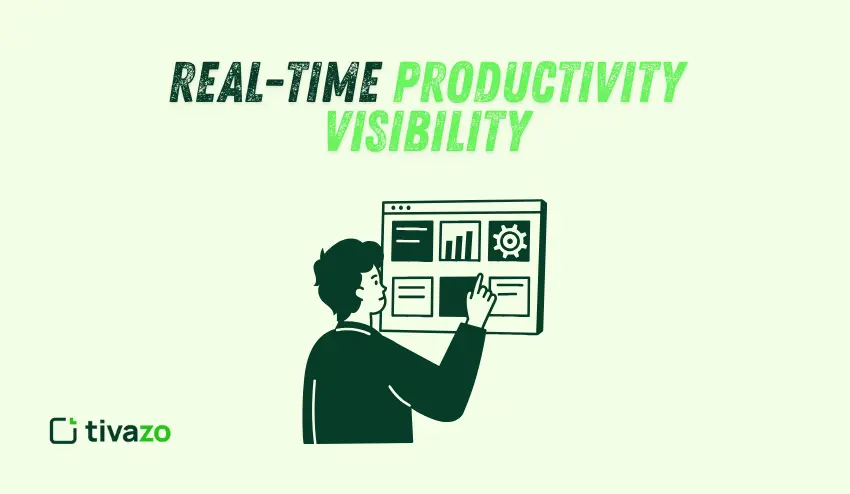10 Minute Rule is not just a time-management strategy; it is a powerful psychological tool that makes it easier to get started on frustrating tasks. By challenging yourself to work on a daunting project for just 10 minutes, the 10 Minute Rule allows you to overcome many of the mental hurdles caused by procrastination and inertia. Whether you’re a student, employee, or entrepreneur, this principle will change how you approach productivity for good.
Key Highlights:
- What is the 10 Minute Rule
- How Does the 10 Minute Rule Work
- Science Behind the 10 Minute Rule
- 10 Minute Rule for ADHD
- 10 Minute Rule For Relationships and Personal Life
- Get Started with the 10 Minute Rule
- Common Mistakes When Using the 10 Minute Rule
What is the 10 Minute Rule in the Context of Productivity?
The 10-minute rule is a simple but effective approach to getting past procrastination. Instead of being overwhelmed by a large task, you simply commit to working on it for just 10 minutes. You aren’t even trying to finish it, just to get started. By breaking things down into small tasks, you reduce the sense of larger mental barriers that keep you from beginning.
Once you do begin, you will often find that it is easier to keep going. You can build a sense of momentum from those first 10 minutes of progress. This rule feeds into our brains’ propensity for small wins, turning what was once an impossible task into something we can get started on, and thus defeating procrastination in favor of productivity.
How Does the 10 Minute Rule Work?
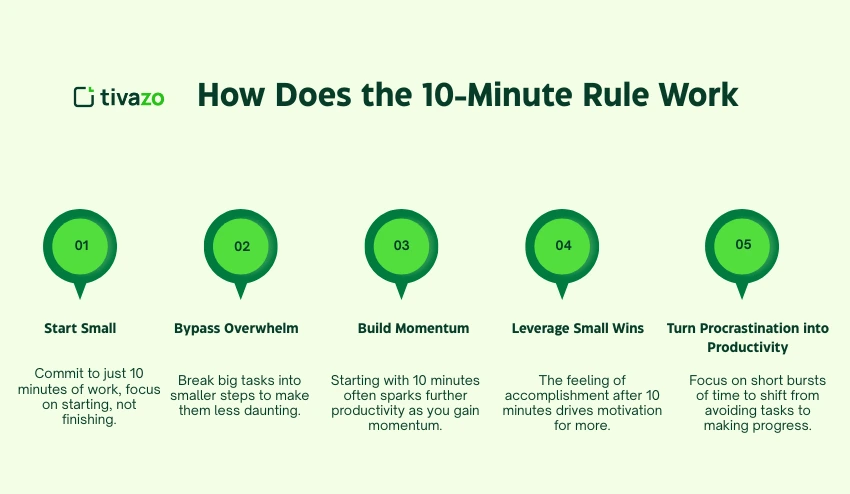
- Start small:
- Commit to doing something for 10 minutes. The goal isn’t to finish the entire thing; the goal is to start.
- Bypass overwhelm:
- You can conquer the barrier of a big task by breaking it down into smaller tasks, which means overcoming the mental hurdle of a larger project.
- Build momentum:
- Once you start, the first 10 minutes often lead to more work. The initial progress creates momentum that keeps you going.
- Leverage small wins:
- The brain loves small victories, and completing 10 minutes of work gives you the feeling of accomplishment, which motivates you to work more.
- Turn procrastination into productivity:
- By having a focus on short chunks of time, you are going from avoiding tasks to making progress.
The Science Behind the 10 Minute Rule: How Small Steps Lead to Big Wins
To understand why the 10 minute rule works, we must consider the psychology behind certain principles and also behavioral science. The 10 Minute Rule is based on the Zeigarnik Effect, which is a documented psychological phenomenon where human brains recall uncompleted tasks better than completed tasks.
The Zeigarnik Effect in Action:
Imagine that you have a big project at hand. The human brain loves unfinished tasks because it gives the brain a sense of “tension” until you complete the task, which is why when you commit to working on something for 10 minutes, you create the mental urge to complete the task, and you often end up working longer than you intended.
Micro-Productivity:
Instead of worrying about a massive and overwhelming project, micro-productivity suggests that smaller, more frequent bursts of work create overall output. The 10 minute rule gives you a manageable burst of work ability, concentrating and engaging you, and fending off mental fatigue.
How the 10 Minute Rule Helps Overcome Procrastination and Boost Focus
Procrastination often comes from thinking about how big a project you have. The 10 minute rule is a perfect solution to this “too big” perception. It breaks down projects into manageable, bite-sized tasks, hence eliminating the negative perception of the task because you are only focusing short term on it.
- The Procrastination Trap:
- More often than not, we tend to procrastinate because we have a task that is too big to handle. The thought of working for hours paralyzes us from even getting started. The 10 minute rule embraces the opposite of “too big.” You only think about the task in 10 minute intervals. Therefore, it eliminates the cognitive load and creates an easier task to think about.
- Building Momentum:
- Once you have started your work, you generally find more momentum to continue, and a 10 minute commitment turns into 30 minutes, then into an hour, etc. The power of momentum kicks in and creates a productive period – the task at hand has small wins that begin to compound.
The 10 Minute Rule for ADHD: A Game-Changer for Focus and Task Initiation
Once you have started your work, you generally find more momentum to continue, and a 10 minute commitment turns into 30 minutes, then into an hour, etc. The power of momentum kicks in and creates a productive period; the task at hand has small wins that begin to compound.
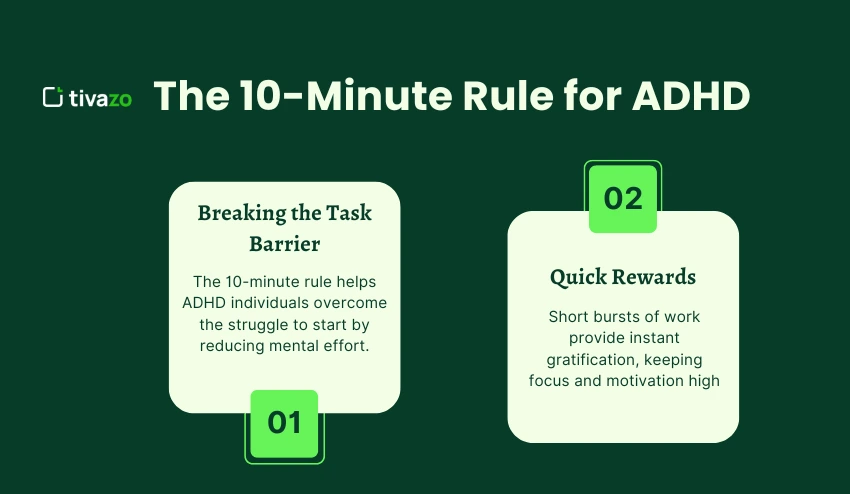
- Breaking the Task Barrier:
- A primary reason individuals with ADHD have trouble with task initiation is the complexity of the task. By committing to completing just 10 minutes of work, ADHD individuals also reduce the activation energy required to initiate the task, thus better focusing on concentrating on the task, which will ultimately lead to more tasks being completed.
- Quick Rewards:
- The short bursts of effort also provide instant satisfaction, which aids ADHD individuals in staying engaged with the task without experiencing complexity paralysis.
How the 10 Minute Rule Can Transform Your Relationships and Personal Life
The 10 minute rule is often associated with work and productivity, but it is just as useful in our personal lives. By committing just 10 minutes a day to focused conversations with, or shared quality time, or meaningful things to enhance our relationship with significant people in our lives, we can improve communication with our more significant people.
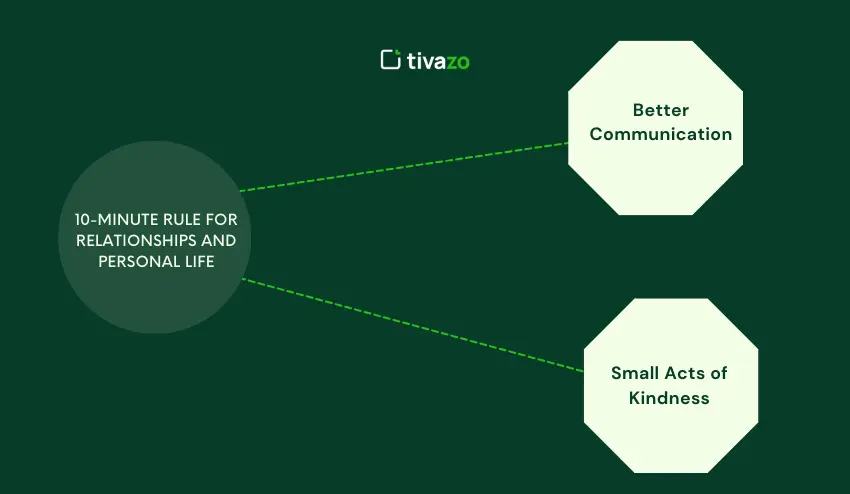
- Better Communication:
- Regardless of who you’re communicating with, a partner, friend, or family member, the commitment of just 10 minutes of focused, undistracted communication will help you develop better emotional connectivity. The same logic applies to work-related tasks.
- Small Acts of Kindness:
- You could use the 10 minute rule to give complete focus and attention to your loved ones, or simply do little things regularly, like giving a compliment, checking on them, or simply sharing your thoughts.
How to Get Started with the 10 Minute Rule: A Step-by-Step Guide
Using 10 minutes is not difficult. Here is how you can implement it properly in any field of your life:
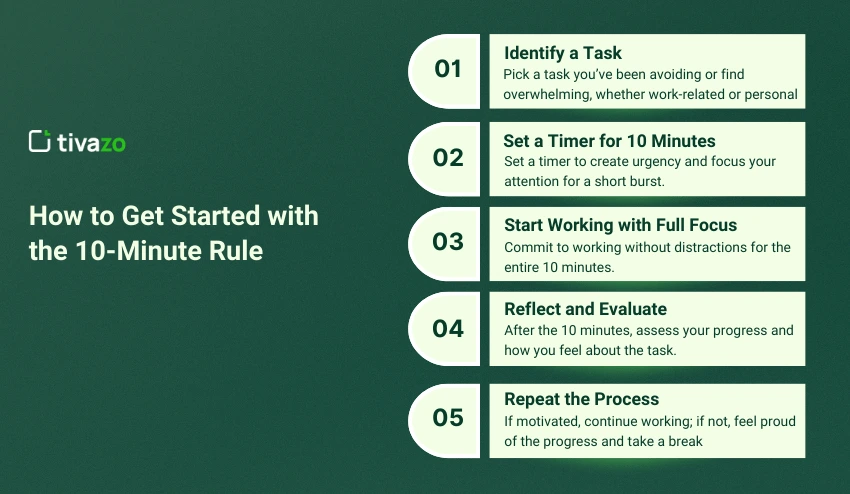
Step 1: Identify a Task
The first step is to think of an activity that you’ve avoided or that seems daunting. This may involve a work project, preparing for an exam, or even a personal development goal like exercise or cleaning. The point is to select something that was on your mind, but it hasn’t been done.
For many learners, even beginning an online class can feel like a daunting task on its own. Breaking it into a simple 10-minute start makes it easier but when schedules get tight, you can also turn to reliable helpers who can do my online class and ensure your academic tasks continue smoothly.
Step 2: Set a Timer for 10 Minutes
Once you have identified the task, it’s time to set a timer for yourself for 10 minutes. You can use a digital timer that you set on your phone, or you can download and even find apps for these. The whole idea of setting a timer is to create a sense of urgency, accountability, and meaning to your work, even if the task itself does not have a deadline.
Step 3: Start Working with Full Focus
Now, focus all your energy and attention on the task for the full 10 minutes. This is crucial; there are no distractions allowed. Put away your phone, close unrelated tabs on your computer, and focus completely on the task at hand. This short burst of intense concentration allows you to make significant progress without feeling overwhelmed.
Step 4: Reflect and Evaluate
At this point, you will want to direct all of your energy towards the task for a committed 10 minutes. This is a critical piece; there will be no distractions. Do not let anything get in the way of you using your brain to work on the task at hand. Put away your phone, shut unrelated tabs or examples/projects on your computer, and only work on the task
Step 5: Repeat the Process
Once the 10 minutes have elapsed, you will want to reflect on how you feel. How do you feel? Did you make progress? Do you feel excited and motivated to keep going, or have you reached a natural stopping point? Reflecting is important to gauge your momentum. If you feel you hit a natural break, then you can step away from the task feeling proud of the work that you completed.
The Pros and Cons of the 10 Minute Rule
As with any productivity method, the 10 minute rule has its advantages and drawbacks.
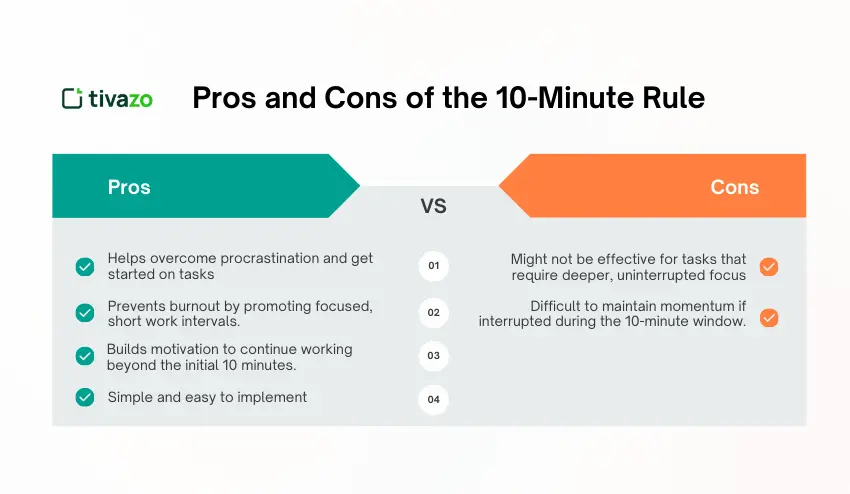
Avoid These Common Mistakes When Using the 10 Minute Rule
The 10 minute rule is simple, but these common mistakes can negatively impact your chances of success:
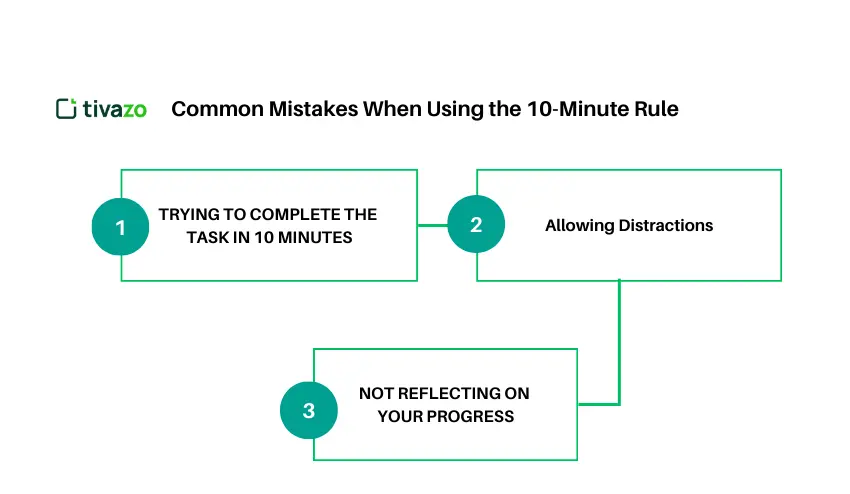
Mistake 1: Trying to Complete the Task in 10 Minutes
Remember, the goal is to make a start, not to finish. Don’t pressure yourself to finish a large task in 10 minutes. Focus on making progress.
Mistake 2: Allowing Distractions
Stay fully engaged in your 10 minute task. Resist the urge to check your phone to see who has messaged you on social media (etc.), as it interrupts your awareness and flow when you desire to remain productive for that solid 10 minutes.
Mistake 3: Not Reflecting on Your Progress
After every session, reflect on what you have done. This will ensure you stay motivated and engaged when working, as you become aware of your progress and how to maximize the technique when it is being effective.
Who Can Benefit from the 10 Minute Rule?
The 10 minute rule can be beneficial for anyone looking to overcome procrastination and increase productivity. Here is an overview of who can utilize the 10 minute rule most effectively:
- Students: Tackle study procrastination and improve focus with short and concentrated ingested.
- Professionals: Break down complex tasks into manageable chunks to stay on track.
- Entrepreneurs: Use the 10 minute rule to manage multiple roles at once with short bursts of focused work.
- Creatives: Use the 10 minute rule to stop procrastinating when creating and increase momentum towards your next big idea.
No matter the task, the 10 minute rule will help you get started more easily and develop your productivity.
Harness the Power of Small Wins to Build Momentum
In this section, I can express how taking small steps to achieve small wins transforms to larger wins and ultimately gives more motivation, and it’s a boost we can sustain over time.
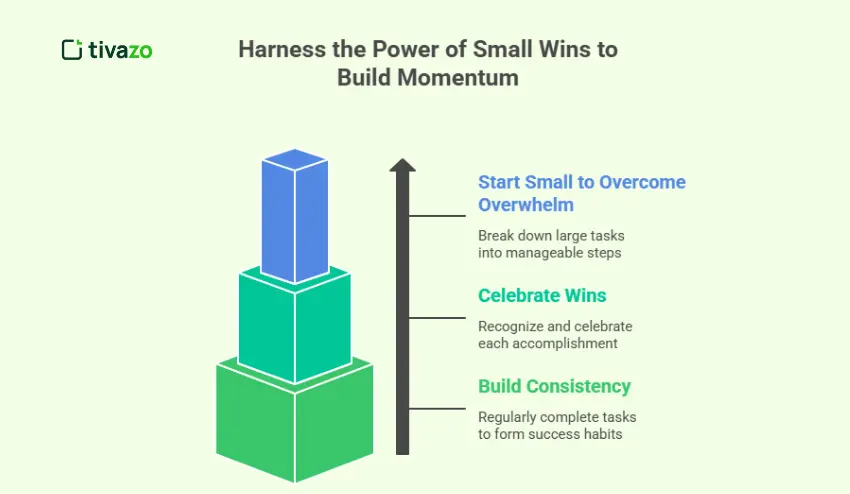
- Start Small to Overcome Overwhelm:
- Large tasks may seem insurmountable, but when broken down into smaller tasks, they become much more manageable. If you are pursuing tasks with the 10 minute rule, you are well on your way to success.
- Celebrate Each Win:
- Whether small or big, recognize and celebrate each accomplishment. This ongoing positive reinforcement creates motivation and confidence.
- Build Consistency:
- Regularly completing small tasks creates a habit of success and makes it increasingly easier to set focus and to stay motivated for a longer period.
Conclusion: Unlock Your Productivity with the 10 Minute Rule
The 10 minute rule is not a one-time productivity hack; it’s a tool for life. It can help you to eliminate procrastination, increase focus, and make meaningful progress by treating a project in small, manageable steps. This rule permits you to apply it whenever you find yourself avoiding a task. It could be a project at work, a study session, or even an uncomfortable conversation that you are avoiding.
Productivity is about being productive and smart while producing tangible savings, your time and effort, and that also means taking tasks in separate chunks. Take it step-by-step! And where can this principle take you? A small amount of time today is only going to lead to greater achievements in the future.

